Bibliometric and Social Network Analysis on the Use of Satellite Imagery in Agriculture: An Entropy-Based Approach
Abstract
1. Introduction
1.1. A Help from Above: The Use of Satellite Imagery in Agriculture
1.2. Satellite Imagery for Agriculture through Different Information Sources
1.3. Aim of the Study
- What are the most influential countries and journals and the key papers in the field?
- What is the spectrum of the terminology related to the use of satellite imagery in agriculture and what are the relations among them?
- What are the main research streams and emerging topics?
- 4.
- Who talks about satellite imagery for agriculture on Twitter and for what purpose?
- 5.
- What are the cutting-edge dynamics and development trends discussed?
2. Materials and Methods
2.1. WOS Dataset Description
2.1.1. Scientific Paper Search
2.1.2. Data Cleaning
2.1.3. Twitter Dataset Description
2.2. Data Analysis
2.2.1. Stemming Words from the Abstracts and Tweets
2.2.2. Bipartite Networks, Entropy-Based Null-Models and Validated Semantic Networks
3. Results and Discussion
3.1. WoS Dataset
3.1.1. Descriptive Statistics
Country Performances
Journal Performances
3.1.2. Most Cited Papers
3.1.3. Most Used Keywords
3.1.4. Semantic Networks
3.2. Twitter Dataset
3.2.1. Descriptive Statistics
3.2.2. Semantic Network
4. Conclusions
Supplementary Materials
Author Contributions
Funding
Data Availability Statement
Conflicts of Interest
Appendix A

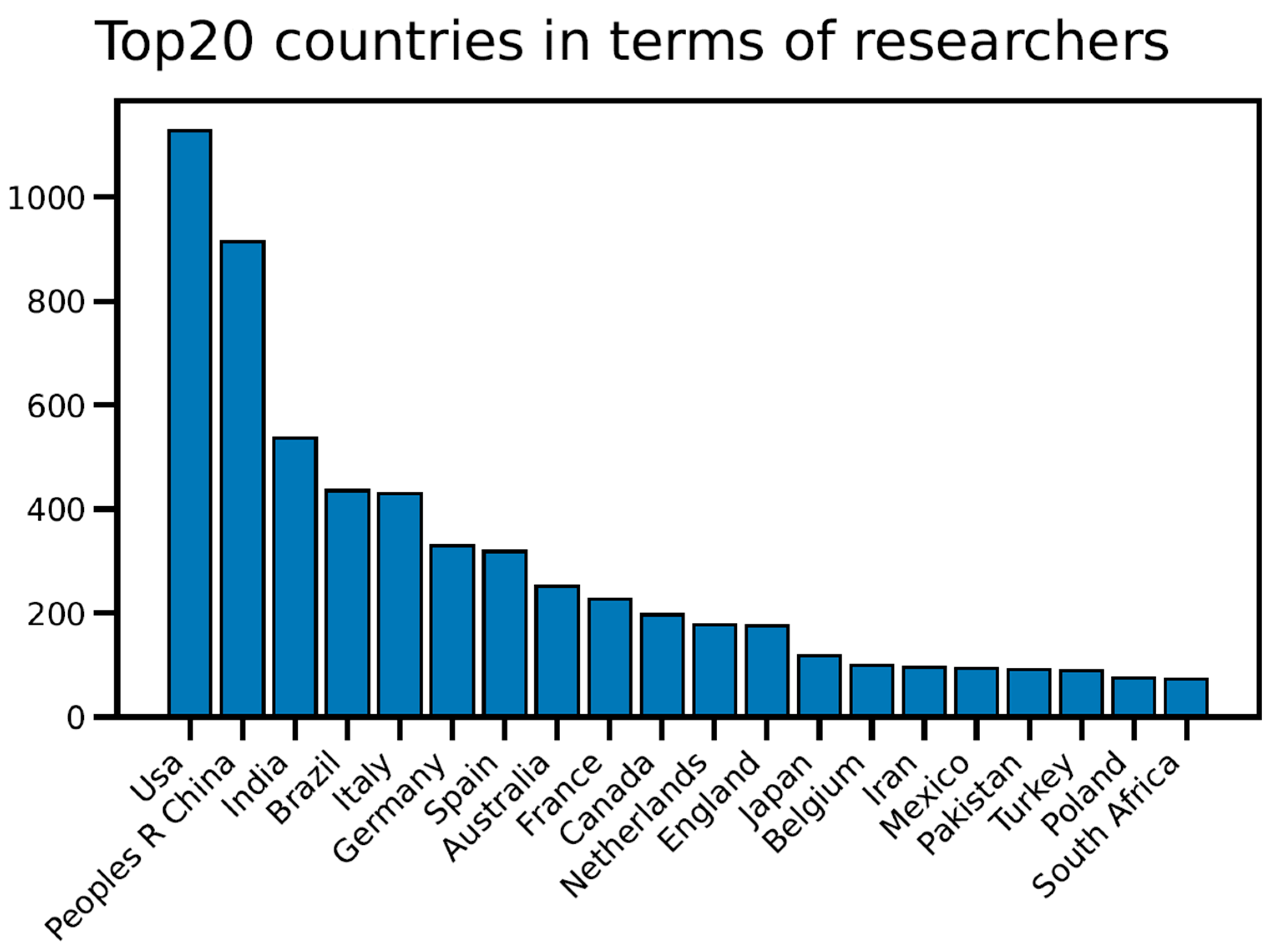
| SATELLITE PLATFORM/INSTRUMENT | SENSOR TYPE | ELECTROMAGNETIC SPECTRUM | VEGETATION INDEX | IMAGERY FEATURES | IMAGE PROCESSING | CROP TYPE | CROP MANAGEMENT |
|---|---|---|---|---|---|---|---|
| ALOS Aqua Gaofen Landsat PlanetScope Pleiades Prisma QuickBird RadarSAT RapidEye Sentinel Terra MODIS * | Hyperspectral Multispectral Radar RGB Thermal | NIR SWIR TIR VIS | EVI GCI GNDVI LAI MSAVI NDRE NDVI NDWI RECl SAVI VARI | Multitemporal Resolution Revisit time | + AI Classification Fusion + DL Interoperability + ML Recognition | Cereals Barley Corn Maize Rice Wheat Banana Oil palm Soybean Sugarcane Potato Tomato Orchards Olive Vineyard | Disease Fertilisation Harvest Pest Phenology Pruning Tillage Sowing Weed Yield |
| Research Field | Keyword | Stem | Frequency | Ranking |
|---|---|---|---|---|
| imagery_features | resolution | resolut | 518 | 34 |
| crop_management | yield | yield | 380 | 65 |
| satellites | landsat | landsat | 290 | 107 |
| vegetation_index | ndvi | ndvi | 288 | 108 |
| image_processing | classification | classifi | 220 | 156 |
| crop_type | wheat | wheat | 178 | 217 |
| satellites | modis | modi | 155 | 268 |
| sensors | radar | radar | 134 | 312 |
| sensors | multispectral | multispectr | 128 | 329 |
| crop_management | harvest | harvest | 119 | 353 |
| vegetation_index | vari | vari | 115 | 363 |
| crop_type | rice | rice | 109 | 380 |
| crop_management | phenology | phenolog | 103 | 416 |
| crop_type | maize | maiz | 94 | 451 |
| vegetation_index | lai | lai | 82 | 506 |
| sensors | hyperspectral | hyperspectr | 79 | 529 |
| sensors | thermal | thermal | 72 | 576 |
| crop_type | corn | corn | 70 | 591 |
| vegetation_index | evi | evi | 58 | 672 |
| crop_type | soybean | soybean | 58 | 674 |
| image_processing | fusion | fusion | 49 | 764 |
| crop_management | disease | diseas | 46 | 794 |
| imagery_features | multitemporal | multitempor | 42 | 866 |
| crop_management | weed | weed | 42 | 867 |
| satellites | sentinel | sentinel | 39 | 891 |
| em_spectrum | vis | vis | 39 | 905 |
| crop_type | cereals | cereal | 36 | 950 |
| crop_type | potato | potato | 33 | 989 |
| crop_management | pest | pest | 32 | 1017 |
| em_spectrum | nir | nir | 30 | 1064 |
| crop_type | barley | barley | 30 | 1057 |
| crop_type | sugarcane | sugarcan | 30 | 1076 |
| crop_management | sowing | sow | 30 | 1060 |
| crop_management | tillage | tillag | 27 | 1135 |
| satellites | quickbird | quickbird | 26 | 1164 |
| satellites | rapideye | rapidey | 26 | 1169 |
| imagery_features | revisit time | revisit | 23 | 1271 |
| crop_type | orchards | orchard | 23 | 1242 |
| vegetation_index | ndwi | ndwi | 22 | 1307 |
| satellites | terra | terra | 22 | 1300 |
| vegetation_index | savi | savi | 21 | 1337 |
| image_processing | ml | ml | 19 | 1444 |
| image_processing | recognition | recognit | 19 | 1428 |
| sensors | rgb | rgb | 18 | 1470 |
| crop_type | olive | oliv | 17 | 1526 |
| crop_type | vineyard | vineyard | 17 | 1517 |
| crop_type | oil palm | palm | 16 | 1594 |
| satellites | alos | alo | 15 | 1612 |
| em_spectrum | tir | tir | 14 | 1686 |
| vegetation_index | gndvi | gndvi | 13 | 1780 |
| satellites | aqua | aqua | 12 | 1841 |
| vegetation_index | ndre | ndre | 11 | 1986 |
| satellites | radarsat | radarsat | 9 | 2164 |
| em_spectrum | swir | swir | 9 | 2171 |
| satellites | planetscope | planetscop | 8 | 2350 |
| crop_type | tomato | tomato | 8 | 2319 |
| vegetation_index | msavi | msavi | 5 | 2944 |
| image_processing | interoperability | interoper | 5 | 2869 |
| image_processing | dl | dl | 4 | 3368 |
| crop_type | banana | banana | 4 | 3451 |
| image_processing | ai | ai | 3 | 4021 |
| satellites | gaofen | gaofen | 2 | 4403 |
| satellites | prisma | prism | 2 | 5033 |
| vegetation_index | gci | gci | 1 | 13,093 |
| vegetation_index | reci | reci | 1 | 8925 |
| satellites | pleiades | pleiad | 1 | 6140 |
| COMMUNITY LABEL | AGRO-METEOROLOGY | STATISTICAL ANALYSIS | RADAR | SOIL PROPERTIES | LAND USE CLASSIFICATION | GEOLOCATION AND NAVIGATION | UNMANNED AERIAL VEHICLE | AI ALGORITHMS | SPECTRAL REGIONS | VEGETATION INDEXES | PLANT GREENNESS |
|---|---|---|---|---|---|---|---|---|---|---|---|
| NUMBER OF NODES | 47 | 37 | 33 | 31 | 31 | 30 | 30 | 27 | 24 | 22 | 22 |
| COMMUNITY COLOR | |||||||||||
| STEMS AND FREQUENCY | evapotranspir 14 | rmse 12 | radar 17 | carbon 6 | classif 13 | navig 23 | unman 13 | machin 9 | band 8 | index 11 | leaf 10 |
| temperature 10 | coeffici 10 | apertur 15 | organ 6 | classifi 8 | gnss 11 | aerial 9 | vector 8 | red 8 | modi 8 | nitrogen 9 | |
| water 8 | regress 9 | sar 13 | soil 6 | lulc 8 | posit 9 | uav 9 | learn 8 | reflect 8 | veget 7 | chlorophyl 9 | |
| precipit8 8 | squar 9 | backscatt 13 | electr 5 | likelihood 7 | kinemat 8 | vehicl 9 | random 7 | infrar 7 | ndvi 7 | n 6 | |
| thermal 7 | moistur 8 | synthet 12 | clay 4 | kappa 7 | receiv 5 | precis 6 | rf 6 | hyperspectr 7 | evi 6 | content 5 | |
| balance 7 | correl 7 | polar 11 | induct 3 | accuraci 6 | rtk 5 | flight 4 | svm 6 | nm 4 | spectroradiomet 5 | -1 4 | |
| surface 7 | error 7 | vv 11 | salin 3 | urban 6 | real-tim 4 | platform 4 | neural 6 | nir 4 | resolut 5 | solar-induc 4 | |
| drought 7 | predict 6 | hh 7 | ec 3 | chang 5 | system 4 | camera 4 | network 5 | near-infrar 4 | normal 4 | kg 4 | |
| et 6 | root 5 | c-band 7 | eca 3 | class 5 | global 4 | dem 3 | convolut 5 | spectral 3 | moder 4 | canopi 3 | |
| energi 6 | mean 5 | l-band 7 | matter 3 | cover 5 | signal 3 | digit 3 | deep 5 | spectra 3 | differ 3 | fertil 3 | |
| rainfall 5 | least 5 | radarsat-2 6 | soc 2 | overal 4 | speed 3 | elev 3 | forest 5 | green 2 | spatial 3 | fluoresc 3 | |
| trmm 4 | plsr 4 | microwav 6 | phosphorus 2 | maximum 4 | geograph 3 | uav-bas 3 | decis 4 | visibl 2 | indic 3 | lai 3 | |
| meteorology 4 | absolut 4 | optic 5 | ph 2 | built-up 3 | gis 2 | height 3 | support 4 | tir 2 | terra 2 | sif 2 | |
| lst 4 | r-2 4 | palsar 5 | appar 2 | supervis 3 | path 2 | rgb 3 | artifici 4 | blue 2 | imag 2 | rate 2 | |
| emiss 4 | retriev 3 | sentinel-1 5 | eddi 2 | bodi 3 | dgps 2 | topographi 2 | tropic 3 | red-edg 2 | high 2 | nutrient 2 | |
| actual 3 | passiv 3 | polarimetr 5 | ecosystem 2 | land 3 | real 2 | srtm 2 | ann 3 | hyperion 2 | savi 2 | ha 2 | |
| sebal 3 | ordinary 3 | vh 3 | depth 2 | sprawl 2 | autonom 2 | man 2 | train 2 | shortwav 2 | low 1 | biomass 2 | |
| vci 3 | partial 3 | alo 3 | fao 1 | mlc 2 | steer 1 | altitud 2 | algorithm 2 | swir 1 | ndwi 1 | biophys 2 | |
| climat 3 | valid 3 | angl 3 | cm 1 | use/land 2 | rs 1 | lidar 2 | deforest 2 | airborn 1 | distribut 1 | photosynthesi 1 | |
| gaug 3 | model 2 | s2 2 | servic 1 | increas 2 | robot 1 | farmer 2 | cnn 2 | multispectr 1 | aqua 1 | absorpt 1 |
References
- Struik, P.C.; Kuyper, T.W. Sustainable intensification in agriculture: The richer shade of green. A review. Agron. Sustain. Dev. 2017, 37, 39. [Google Scholar] [CrossRef]
- Barrett, H.; Rose, D.C. Perceptions of the Fourth Agricultural Revolution: What’s In, What’s Out, and What Consequences are Anticipated? Sociol. Ruralis 2022, 62, 162–189. [Google Scholar] [CrossRef]
- Lowenberg-Deboer, J.; Erickson, B. Setting the Record Straight on Precision Agriculture Adoption. Agron. J. 2019, 111, 1552–1569. [Google Scholar] [CrossRef]
- EUSPA. Report on Road User Needs and Requirements Outcome of the EUSPA User Consultation Platform; European Union Agency for the Space Programme: Prague, Czech Republic, 2022. [Google Scholar]
- Sishodia, R.P.; Ray, R.L.; Singh, S.K. Applications of Remote Sensing in Precision Agriculture: A Review. Remote Sens. 2020, 12, 3136. [Google Scholar] [CrossRef]
- Pabian, F. Commercial Satellite Imagery as an Evolving Open-Source Verification Technology: Emerging Trends and Their Impact for Nuclear Nonproliferation Analysis, EUR27687; Publications Office of the European Union: Luxembourg, 2015; ISBN 9789279542695. [Google Scholar] [CrossRef]
- Kumar, S.; Meena, R.S.; Sheoran, S.; Jangir, C.K.; Jhariya, M.K.; Banerjee, A.; Raj, A. Remote sensing for agriculture and resource management. Nat. Resour. Conserv. Adv. Sustain. 2022, 5, 91–135. [Google Scholar] [CrossRef]
- EOS. Data. Analytics. Available online: https://eos.com/ (accessed on 23 October 2022).
- Zhu, L.; Suomalainen, J.; Liu, J.; Hyyppä, J.; Kaartinen, H.; Haggren, H. A Review: Remote Sensing Sensors. Multi Purp. Appl. Geospat. Data 2018, 2, 1–24. [Google Scholar] [CrossRef]
- Global Strategy to Improve Agricultural and Rural Statistics (GSARS). Handbook on Remote Sensing for Agricultural Statistics; Global Strategy to Improve Agricultural and Rural Statistics: Rome, Italy, 2017; pp. 1–287. [Google Scholar]
- Okolie, C.J.; Smit, J.L. A systematic review and meta-analysis of Digital elevation model (DEM) fusion: Pre-processing, methods and applications. ISPRS J. Photogramm. Remote Sens. 2022, 188, 1–29. [Google Scholar] [CrossRef]
- Santaga, F.S.; Benincasa, P.; Toscano, P.; Antognelli, S.; Ranieri, E.; Vizzari, M. Simplified and advanced sentinel-2-based precision nitrogen management of wheat. Agronomy 2021, 11, 1156. [Google Scholar] [CrossRef]
- Ma, C.; Johansen, K.; McCabe, M.F. Combining Sentinel-2 data with an optical-trapezoid approach to infer within-field soil moisture variability and monitor agricultural production stages. Agric. Water Manag. 2022, 274, 107942. [Google Scholar] [CrossRef]
- Meng, J.; Xu, J.; You, X. Optimizing soybean harvest date using HJ-1 satellite imagery. Precis. Agric. 2015, 16, 164–179. [Google Scholar] [CrossRef]
- OneSoil. Available online: https://onesoil.ai/en (accessed on 23 October 2022).
- Skyward Apps. Available online: https://skywardapps.com/ (accessed on 23 October 2022).
- Climate Field View. Available online: https://www.climatefieldview.it/ (accessed on 23 October 2022).
- Jones, E.G.; Wong, S.; Milton, A.; Sclauzero, J.; Whittenbury, H.; McDonnell, M.D. The impact of pan-sharpening and spectral resolution on vineyard segmentation through machine learning. Remote Sens. 2020, 12, 934. [Google Scholar] [CrossRef]
- Dimitrov, P.; Dong, Q.; Eerens, H.; Gikov, A.; Filchev, L.; Roumenina, E.; Jelev, G. Sub-pixel crop type classification using PROBA-V 100 m NDVI time series and reference data from Sentinel-2 classifications. Remote Sens. 2019, 11, 1370. [Google Scholar] [CrossRef]
- Misra, G.; Cawkwell, F.; Wingler, A. Status of phenological research using sentinel-2 data: A review. Remote Sens. 2020, 12, 2760. [Google Scholar] [CrossRef]
- Bertoglio, R.; Corbo, C.; Renga, F.M.; Matteucci, M. The Digital Agricultural Revolution: A Bibliometric Analysis Literature Review. IEEE Access 2021, 9, 134762–134782. [Google Scholar] [CrossRef]
- Zupic, I.; Čater, T. Bibliometric Methods in Management and Organization. Organ. Res. Methods 2015, 18, 429–472. [Google Scholar] [CrossRef]
- Maditati, D.R.; Munim, Z.H.; Schramm, H.J.; Kummer, S. A review of green supply chain management: From bibliometric analysis to a conceptual framework and future research directions. Resour. Conserv. Recycl. 2018, 139, 150–162. [Google Scholar] [CrossRef]
- Aria, M.; Cuccurullo, C. Bibliometrix: An R-tool for comprehensive science mapping analysis. J. Informetr. 2017, 11, 959–975. [Google Scholar] [CrossRef]
- Wang, J.; Wang, S.; Zou, D.; Chen, H.; Zhong, R.; Li, H.; Zhou, W.; Yan, K. Social network and bibliometric analysis of unmanned aerial vehicle remote sensing applications from 2010 to 2021. Remote Sens. 2021, 13, 2912. [Google Scholar] [CrossRef]
- Yuan, S.; Oshita, T.; AbiGhannam, N.; Dudo, A.; Besley, J.C.; Koh, H.E. Two-way communication between scientists and the public: A view from science communication trainers in North America. Int. J. Sci. Educ. Part B Commun. Public Engagem. 2017, 7, 341–355. [Google Scholar] [CrossRef]
- Sanders, C.E.; Mayfield-Smith, K.A.; Lamm, A.J. Exploring twitter discourse around the use of artificial intelligence to advance agricultural sustainability. Sustainability 2021, 13, 12033. [Google Scholar] [CrossRef]
- Jindo, K.; Kozan, O.; Iseki, K.; Maestrini, B.; van Evert, F.K.; Wubengeda, Y.; Arai, E.; Shimabukuro, Y.E.; Sawada, Y.; Kempenaar, C. Potential utilization of satellite remote sensing for field-based agricultural studies. Chem. Biol. Technol. Agric. 2021, 8, 58. [Google Scholar] [CrossRef]
- Yang, C. High resolution satellite imaging sensors for precision agriculture. Front. Agric. Sci. Eng. 2018, 5, 393–405. [Google Scholar] [CrossRef]
- Moher, D.; Liberati, A.; Tetzlaff, J.; Altman, D.G. Preferred reporting items for systematic reviews and meta-analyses: The PRISMA statement. BMJ 2009, 339, 332–336. [Google Scholar] [CrossRef] [PubMed]
- GET /2/Tweets/Search/All. Available online: https://developer.twitter.com/en/docs/twitter-api/tweets/search/api-reference/get-tweets-search-all (accessed on 27 November 2022).
- Academic Access. Available online: https://developer.twitter.com/en/products/twitter-api/academic-research (accessed on 27 November 2022).
- Radicioni, T.; Saracco, F.; Pavan, E.; Squartini, T. Analysing Twitter semantic networks: The case of 2018 Italian elections. Sci. Rep. 2021, 11, 13207. [Google Scholar] [CrossRef]
- Loper, E.; Bird, S. NLTK: The Natural Language Toolkit. In Proceedings of the ACL Workshop on Effective Tools and Methodologies for Teaching Natural Language Processing and Computational Linguistics, Philadelphia, PA, USA, 7 July 2002; pp. 69–72. [Google Scholar] [CrossRef]
- Caldarelli, G. Scale-Free Networks Complex Webs in Nature and Technology; Oxford University Press: Oxford, UK, 2010. [Google Scholar]
- Cimini, G.; Squartini, T.; Saracco, F.; Garlaschelli, D.; Gabrielli, A.; Caldarelli, G. The Statistical Physics of Real-World Networks. Nat. Rev. Phys. 2018, 1, 58–71. [Google Scholar] [CrossRef]
- Jaynes, E.T. Information theory and statistical mechanics. Phys. Rev. 1957, 106, 620–630. [Google Scholar] [CrossRef]
- Park, J.; Newman, M.E.J. Statistical mechanics of networks. Phys. Rev. E—Stat. Nonlinear Soft Matter Phys. 2004, 70, 066117. [Google Scholar] [CrossRef]
- Garlaschelli, D.; Loffredo, M.I. Maximum likelihood: Extracting unbiased information from complex networks. Phys. Rev. E—Stat. Nonlinear Soft Matter Phys. 2008, 78, 015101. [Google Scholar] [CrossRef]
- Squartini, T.; Garlaschelli, D. Analytical maximum-likelihood method to detect patterns in real networks. New J. Phys. 2011, 13, 083001. [Google Scholar] [CrossRef]
- Saracco, F.; Di Clemente, R.; Gabrielli, A.; Squartini, T. Randomizing bipartite networks: The case of the World Trade Web. Sci. Rep. 2015, 5, 10595. [Google Scholar] [CrossRef]
- Vallarano, N.; Bruno, M.; Marchese, E.; Trapani, G.; Saracco, F.; Cimini, G.; Zanon, M.; Squartini, T. Fast and scalable likelihood maximization for Exponential Random Graph Models with local constraints. Sci. Rep. 2021, 11, 15227. [Google Scholar] [CrossRef] [PubMed]
- Saracco, F.; Straka, M.J.; Di Clemente, R.; Gabrielli, A.; Caldarelli, G.; Squartini, T. Inferring monopartite projections of bipartite networks: An entropy-based approach. New J. Phys. 2017, 19, 053022. [Google Scholar] [CrossRef]
- Morgan, A.C.; Economou, D.J.; Way, S.F.; Clauset, A. Prestige drives epistemic inequality in the diffusion of scientific ideas. EPJ Data Sci. 2018, 7, 40. [Google Scholar] [CrossRef]
- Kauffman, S.A. Investigations: The Nature of Autonomous Agents and the Worlds They Mutually Create; Santa Fe Institute: Santa Fe, NM, USA, 1996; Volume 207. [Google Scholar]
- Tria, F.; Loreto, V.; Servedio, V.D.P.; Strogatz, S.H. The dynamics of correlated novelties. Sci. Rep. 2014, 4, 5890. [Google Scholar] [CrossRef] [PubMed]
- Newman, M.E.J. The first-mover advantage in scientific publication. Europhys. Lett. 2009, 86, 68001. [Google Scholar] [CrossRef]
- Kussul, N.; Lavreniuk, M.; Skakun, S.; Shelestov, A. Deep Learning Classification of Land Cover and Crop Types Using Remote Sensing Data. IEEE Geosci. Remote Sens. Lett. 2017, 14, 778–782. [Google Scholar] [CrossRef]
- Morton, D.C.; DeFries, R.S.; Shimabukuro, Y.E.; Anderson, L.O.; Arai, E.; Del Bon Espirito-Santo, F.; Freitas, R.; Morisette, J. Cropland expansion changes deforestation dynamics in the southern Brazilian Amazon. Proc. Natl. Acad. Sci. USA 2006, 103, 14637–14641. [Google Scholar] [CrossRef] [PubMed]
- Macedo, M.N.; DeFries, R.S.; Morton, D.C.; Stickler, C.M.; Galford, G.L.; Shimabukuro, Y.E. Decoupling of deforestation and soy production in the southern Amazon during the late 2000s. Proc. Natl. Acad. Sci. USA 2012, 109, 1341–1346. [Google Scholar] [CrossRef] [PubMed]
- Castillejo-González, I.L.; López-Granados, F.; García-Ferrer, A.; Peña-Barragán, J.M.; Jurado-Expósito, M.; de la Orden, M.S.; González-Audicana, M. Object- and pixel-based analysis for mapping crops and their agro-environmental associated measures using QuickBird imagery. Comput. Electron. Agric. 2009, 68, 207–215. [Google Scholar] [CrossRef]
- Arvor, D.; Jonathan, M.; Meirelles, M.S.P.; Dubreuil, V.; Durieux, L. Classification of MODIS EVI time series for crop mapping in the state of Mato Grosso, Brazil. Int. J. Remote Sens. 2011, 32, 7847–7871. [Google Scholar] [CrossRef]
- Forkuor, G.; Hounkpatin, O.K.L.; Welp, G.; Thiel, M. High resolution mapping of soil properties using Remote Sensing variables in south-western Burkina Faso: A comparison of machine learning and multiple linear regression models. PLoS ONE 2017, 12, e0170478. [Google Scholar] [CrossRef]
- Gomez, C.; Viscarra Rossel, R.A.; McBratney, A.B. Soil organic carbon prediction by hyperspectral remote sensing and field vis-NIR spectroscopy: An Australian case study. Geoderma 2008, 146, 403–411. [Google Scholar] [CrossRef]
- Scanlon, B.R.; Faunt, C.C.; Longuevergne, L.; Reedy, R.C.; Alley, W.M.; McGuire, V.L.; McMahon, P.B. Groundwater depletion and sustainability of irrigation in the US High Plains and Central Valley. Proc. Natl. Acad. Sci. USA 2012, 109, 9320–9325. [Google Scholar] [CrossRef]
- Ren, J.; Chen, Z.; Zhou, Q.; Tang, H. Regional yield estimation for winter wheat with MODIS-NDVI data in Shandong, China. Int. J. Appl. Earth Obs. Geoinf. 2008, 10, 403–413. [Google Scholar] [CrossRef]
- Johnson, L.F.; Roczen, D.E.; Youkhana, S.K.; Nemani, R.R.; Bosch, D.F. Mapping vineyard leaf area with multispectral satellite imagery. Comput. Electron. Agric. 2003, 38, 33–44. [Google Scholar] [CrossRef]
- Lee, W.S.; Alchanatis, V.; Yang, C.; Hirafuji, M.; Moshou, D.; Li, C. Sensing Technologies for Precision Specialty Crop Production. Comput. Electron. Agric. 2010, 74, 2–33. [Google Scholar] [CrossRef]
- Moulin, S.; Bondeau, A.; Delecolle, R. Combining Agricultural Crop Models and Satellite Observations: From Field to Regional Scales. Int. J. Remote Sens. 1998, 19, 1021–1036. [Google Scholar] [CrossRef]
- Mc Nairn, H.; Brisco, B. The application of C-band polarimetric SAR for agriculture: A review. Can. J. Remote Sens. 2004, 30, 525–542. [Google Scholar] [CrossRef]
- FAOSTAT. Available online: https://www.fao.org/faostat/en/#home (accessed on 27 November 2022).
- Blondel, V.D.; Guillaume, J.-L.; Lambiotte, R.; Lefebvre, E.; Lambiotte, R.; Lefebvre, E. Fast unfolding of communities in large networks. J. Stat. Mech. Theory Exp. 2008, 10008, 6. [Google Scholar] [CrossRef]
- Mattei, M.; Caldarelli, G.; Squartini, T.; Saracco, F. Italian Twitter semantic network during the Covid-19 epidemic. EPJ Data Sci. 2021, 10, 47. [Google Scholar] [CrossRef]
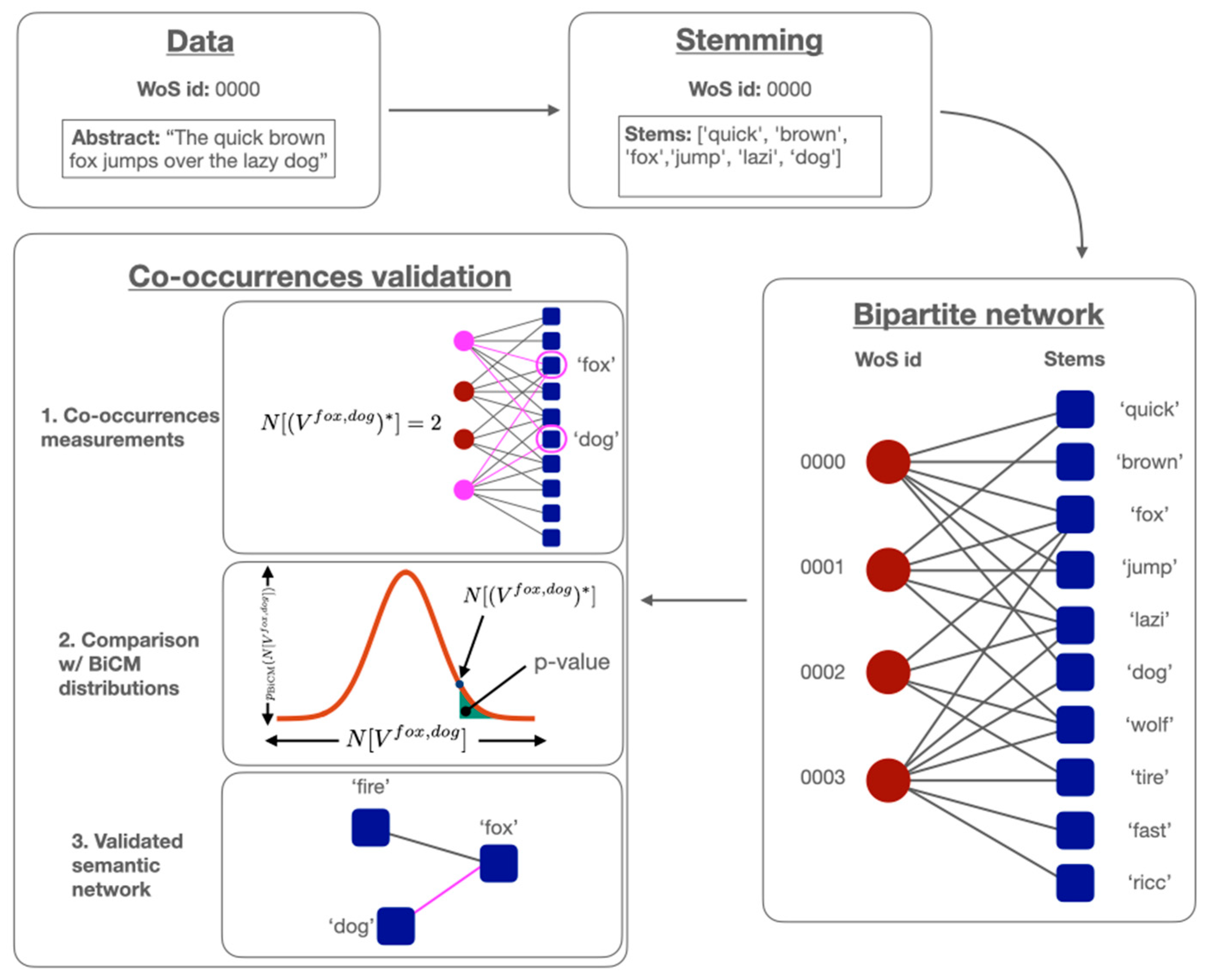
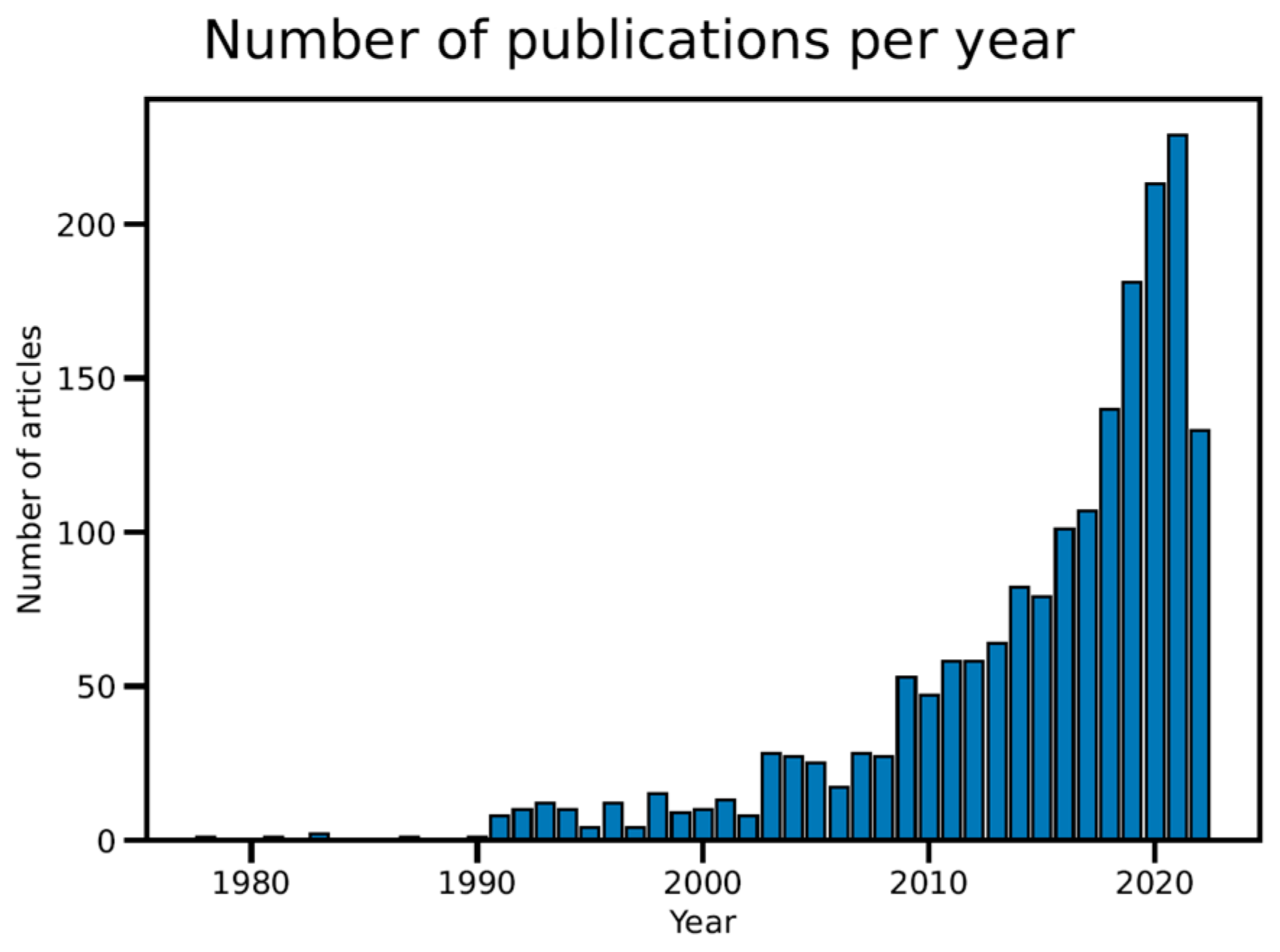

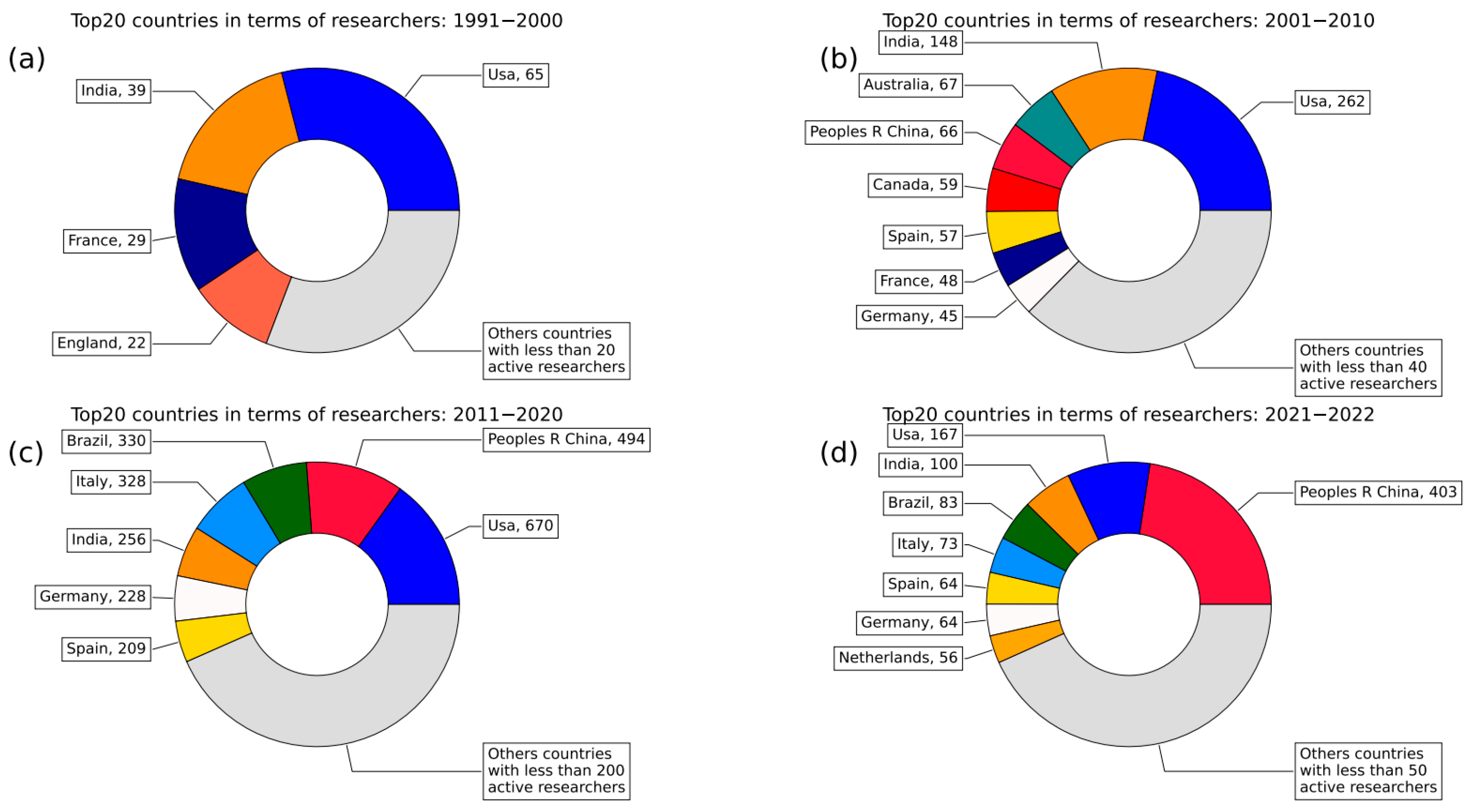
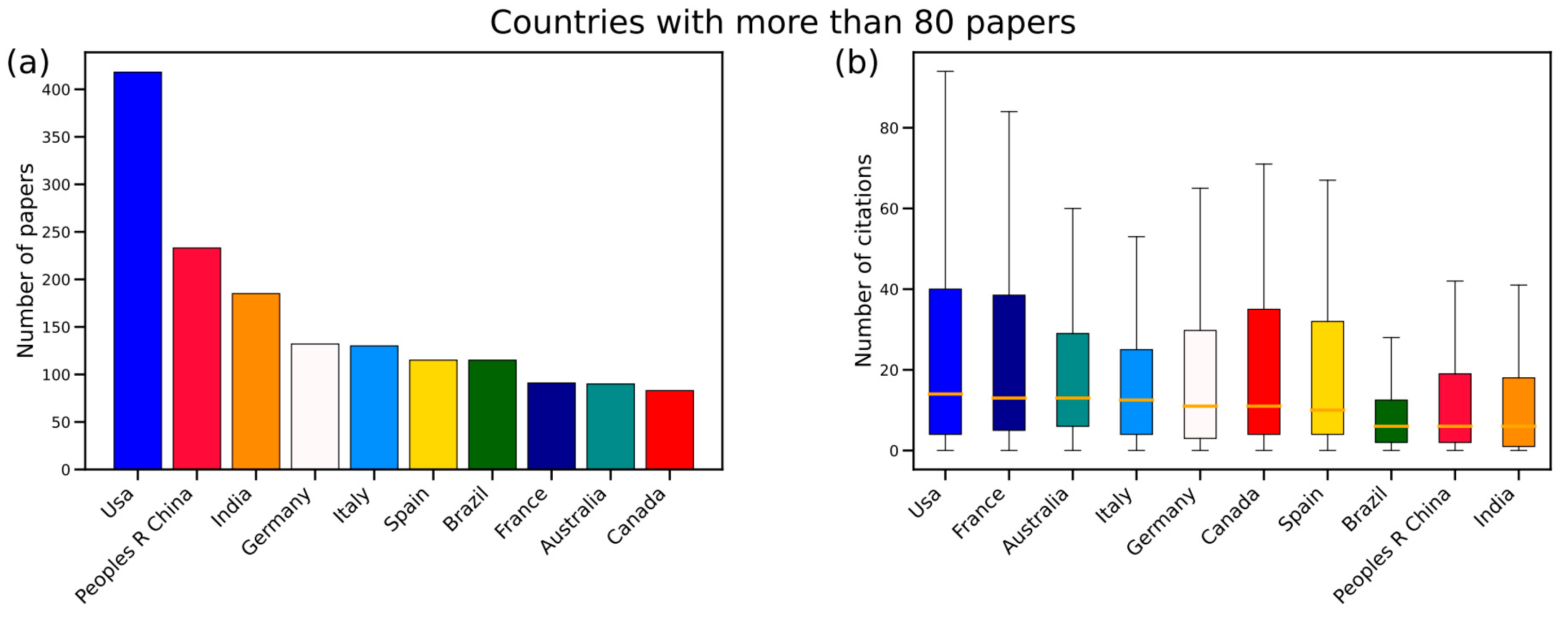
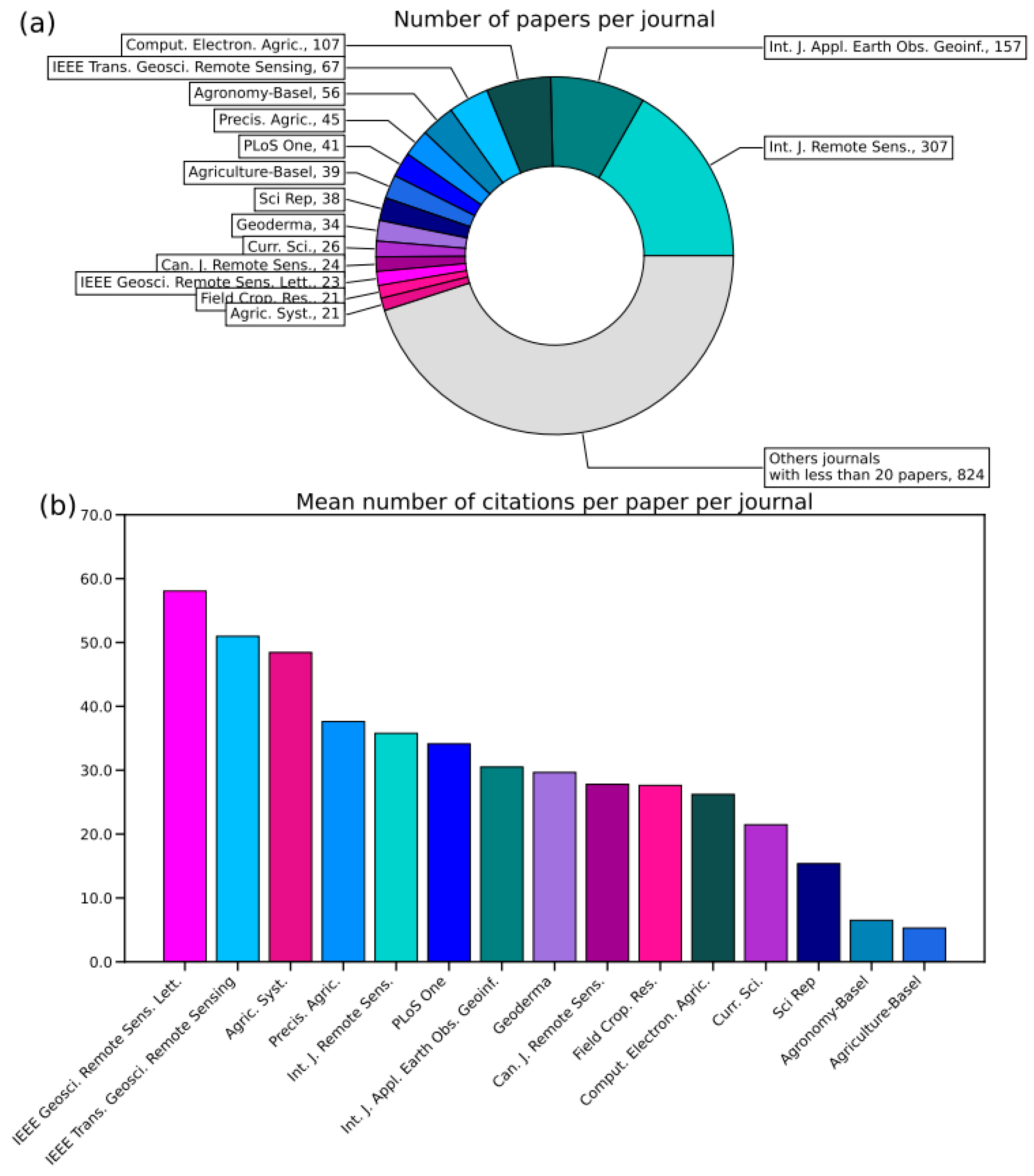

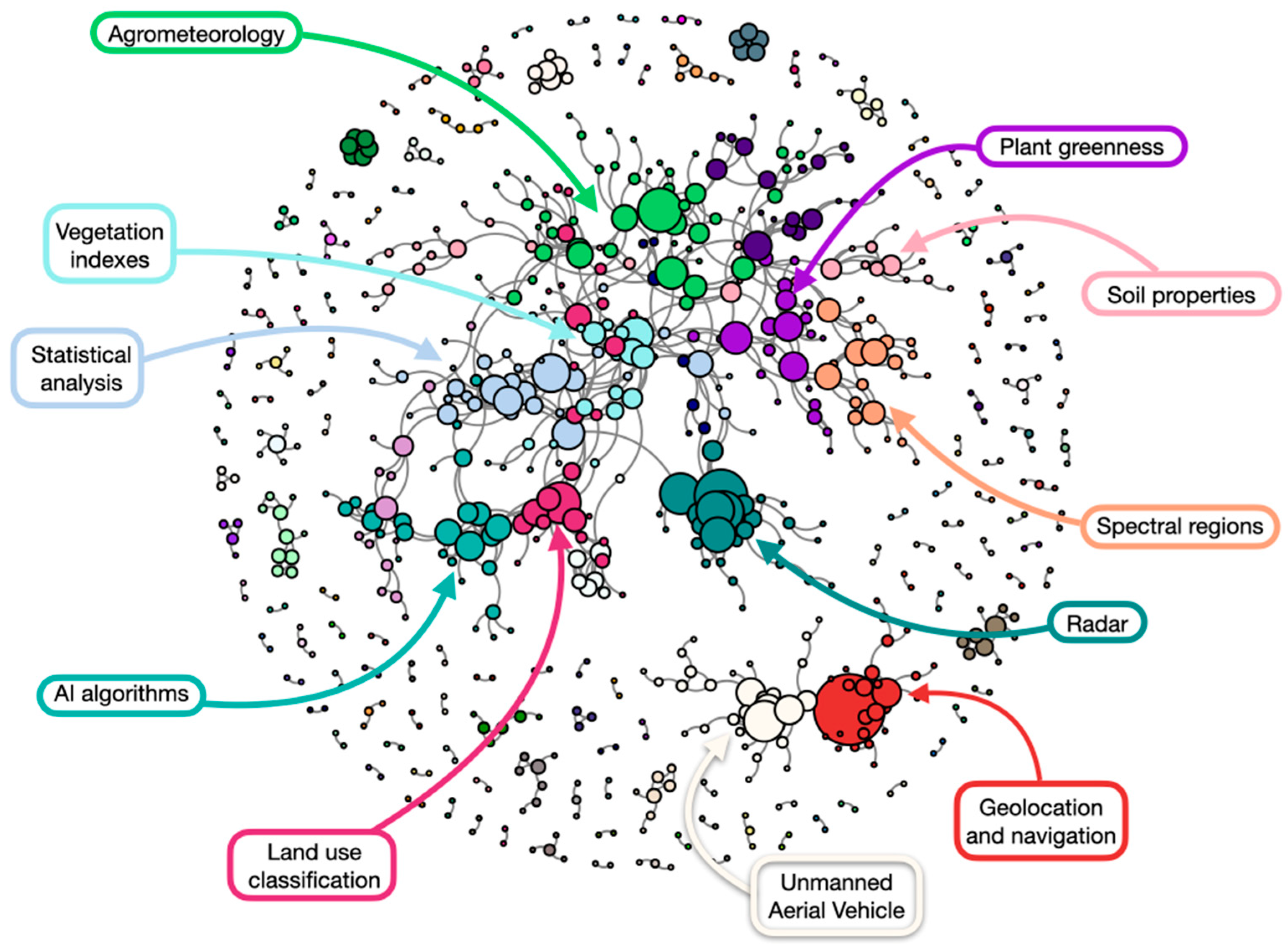
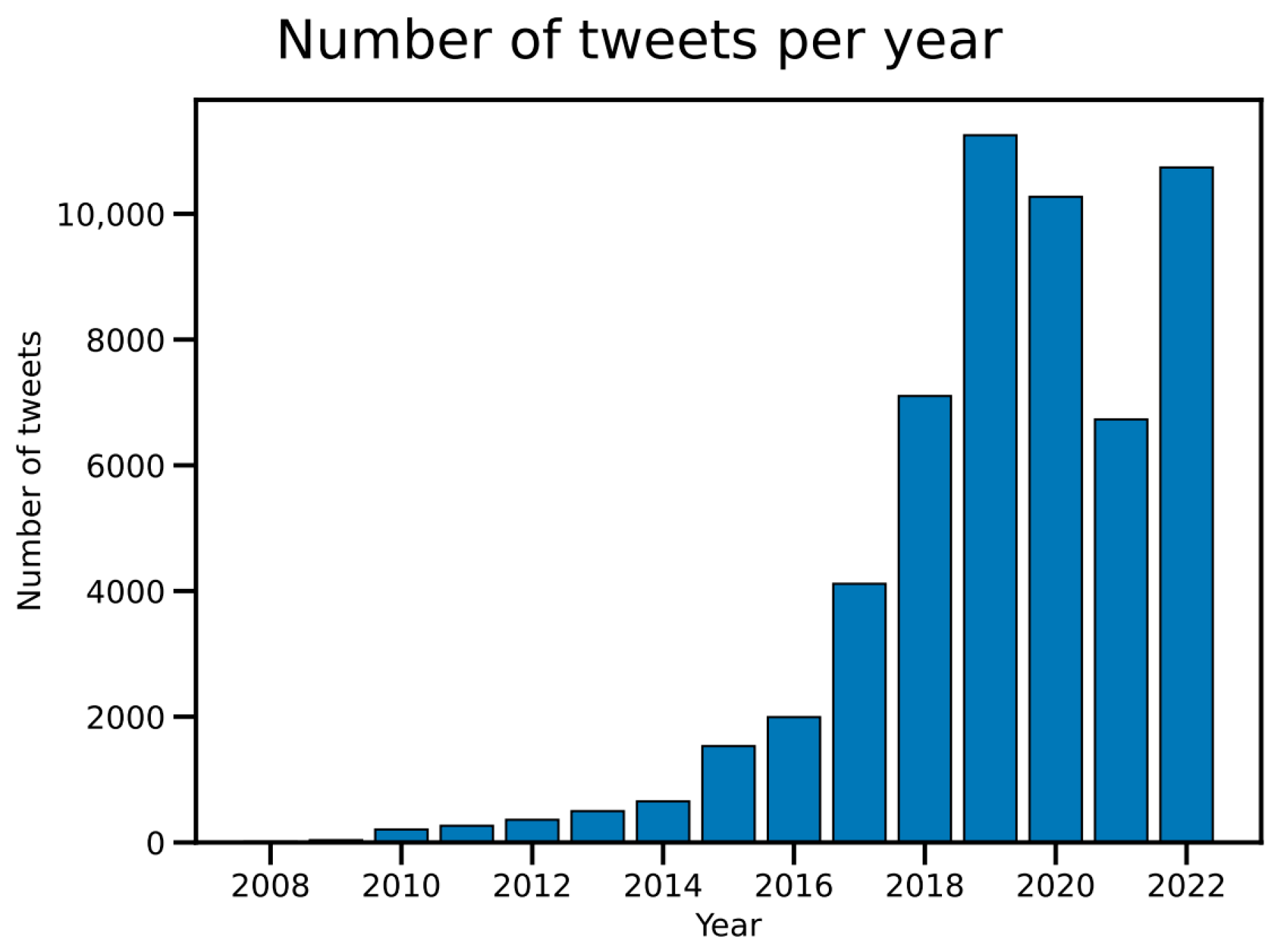
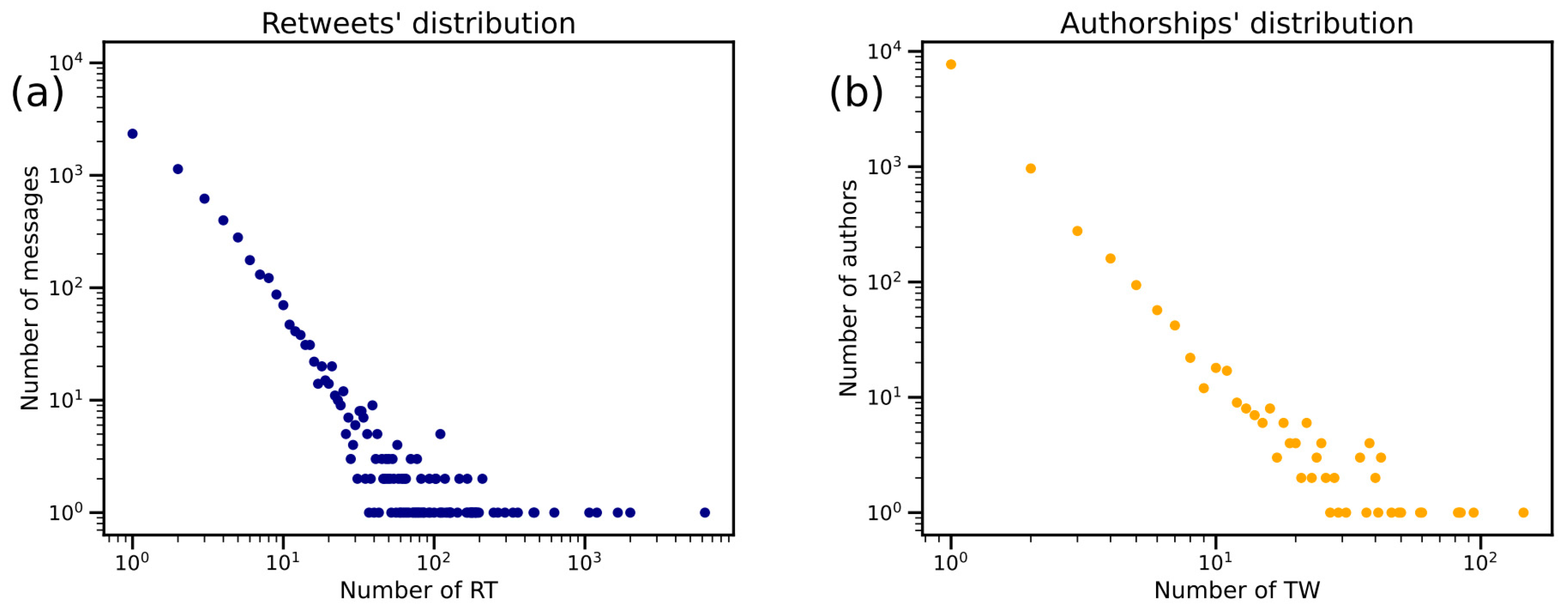
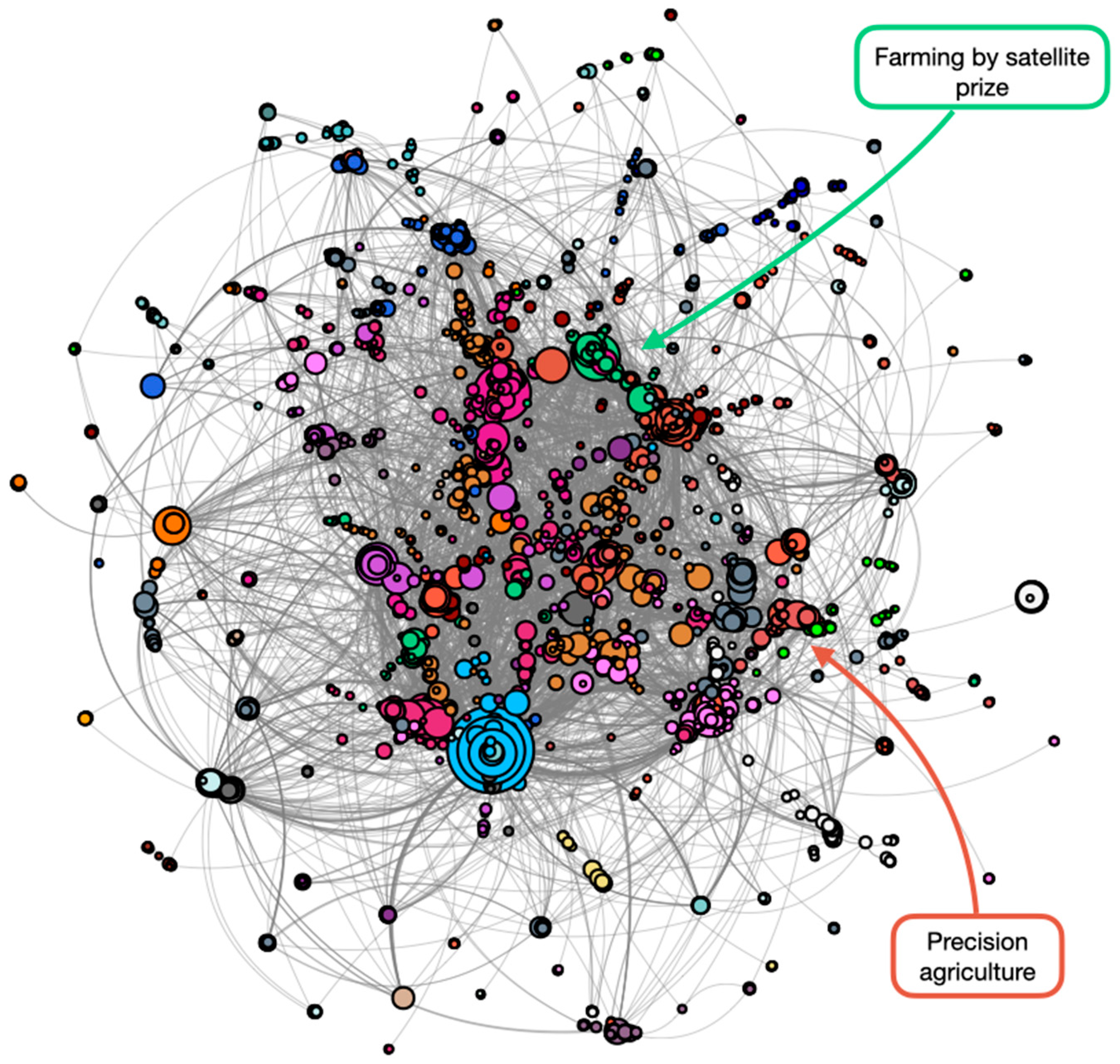
| AGRICULTURAL RANKING | AUTHORS | YEAR | TITLE | JOURNAL | CITATIONS |
|---|---|---|---|---|---|
| 1 | Scanlon et al. | 2012 | Groundwater depletion and sustainability of irrigation in the US High Plains and Central Valley | PNAS | 674 |
| 2 | Kussul et al. | 2017 | Deep Learning Classification of Land Cover and Crop Types Using Remote Sensing Data | IEEE Geosci. Remote Sens. Lett. | 665 |
| 3 | Morton et al. | 2006 | Cropland expansion changes deforestation dynamics in the southern Brazilian Amazon | PNAS | 618 |
| 4 | Macedo et al. | 2012 | Decoupling of deforestation and soy production in the southern Amazon during the late 2000s | PNAS | 374 |
| 5 | Gomez et al. | 2008 | Soil organic carbon prediction by hyperspectral remote sensing and field vis-NIR spectroscopy: An Australian case study | Geoderma | 346 |
| 6 | Solberg et al. | 1996 | A Markov random field model for classification of multisource satellite imagery | IEEE Trans. Geosci. Remote Sensing | 309 |
| 7 | Lee et al. | 2010 | Sensing technologies for precision specialty crop production | Comput. Electron. Agric. | 272 |
| 8 | Moulin et al. | 1998 | Combining agricultural crop models and satellite observations: from field to regional scales | Int. J. Remote Sens. | 267 |
| 9 | Carlson et al. | 2012 | Committed carbon emissions, deforestation, and community land conversion from oil palm plantation expansion in West Kalimantan, Indonesia | PNAS | 260 |
| 10 | Ren et al. | 2008 | Regional yield estimation for winter wheat with MODIS-NDVI data in Shandong, China | Int. J. Appl. Earth Obs. Geoinf. | 217 |
| 11 | McNairn and Brisco | 2004 | The application of C-band polarimetric SAR for agriculture: a review | Can. J. Remote Sens. | 208 |
| 12 | Forkuor et al. | 2017 | High Resolution Mapping of Soil Properties Using Remote Sensing Variables in South-Western Burkina Faso: A Comparison of Machine Learning and Multiple Linear Regression Models | PLoS One | 187 |
| 13 | Johnson et al. | 2003 | Mapping vineyard leaf area with multispectral satellite imagery | Comput. Electron. Agric. | 179 |
| 14 | Castillejo-Gonzalez et al. | 2009 | Object- and pixel-based analysis for mapping crops and their agro-environmental associated measures using QuickBird imagery | Comput. Electron. Agric. | 172 |
| 15 | Lopez-Granados | 2011 | Weed detection for site-specific weed management: mapping and real-time approaches | Weed Res. | 168 |
| 16 | Delegido et al. | 2013 | A red-edge spectral index for remote sensing estimation of green LAI over agroecosystems | Eur. J. Agron. | 164 |
| 17 | Muller et al. | 2013 | Comparing the determinants of cropland abandonment in Albania and Romania using boosted regression trees | Agric. Syst. | 163 |
| 18 | Serra et al. | 2003 | Post-classification change detection with data from different sensors: some accuracy considerations | Int. J. Remote Sens. | 162 |
| 19 | Burke and Lobell | 2017 | Satellite-based assessment of yield variation and its determinants in smallholder African systems | PNAS | 156 |
| 20 | Arvor et al. | 2011 | Classification of MODIS EVI time series for crop mapping in the state of Mato Grosso, Brazil | Int. J. Remote Sens. | 155 |
| Overall Top 10 | Selected Top 10 | ||
|---|---|---|---|
| Stem | Betweenness | Stem | Betweenness |
| coeffici | 1 | modi | 0.346 |
| moistur | 0.838 | thermal | 0.332 |
| soil | 0.779 | yield | 0.269 |
| leaf | 0.73 | radar | 0.26 |
| index | 0.662 | wheat | 0.174 |
| kappa | 0.646 | evi | 0.136 |
| correl | 0.565 | resolut | 0.125 |
| backscatt | 0.547 | hyperspectr | 0.1 |
| temperatur | 0.535 | ndvi | 0.075 |
| classif | 0.512 | landsat | 0.061 |
| Overall Top 10 | Selected Top 10 | ||
|---|---|---|---|
| Stem | Betweenness | Stem | Betweenness |
| iot | 1.000 | radar | 0.400 |
| co2 | 0.933 | ai | 0.303 |
| ecosensenow | 0.903 | yield | 0.164 |
| imag | 0.682 | thermal | 0.101 |
| earth | 0.669 | resolut | 0.092 |
| fire | 0.641 | landsat | 0.055 |
| emiss | 0.633 | rice | 0.044 |
| launch | 0.628 | pest | 0.043 |
| farm | 0.627 | harvest | 0.040 |
| prize | 0.621 | aqua | 0.039 |
Disclaimer/Publisher’s Note: The statements, opinions and data contained in all publications are solely those of the individual author(s) and contributor(s) and not of MDPI and/or the editor(s). MDPI and/or the editor(s) disclaim responsibility for any injury to people or property resulting from any ideas, methods, instructions or products referred to in the content. |
© 2023 by the authors. Licensee MDPI, Basel, Switzerland. This article is an open access article distributed under the terms and conditions of the Creative Commons Attribution (CC BY) license (https://creativecommons.org/licenses/by/4.0/).
Share and Cite
Dainelli, R.; Saracco, F. Bibliometric and Social Network Analysis on the Use of Satellite Imagery in Agriculture: An Entropy-Based Approach. Agronomy 2023, 13, 576. https://doi.org/10.3390/agronomy13020576
Dainelli R, Saracco F. Bibliometric and Social Network Analysis on the Use of Satellite Imagery in Agriculture: An Entropy-Based Approach. Agronomy. 2023; 13(2):576. https://doi.org/10.3390/agronomy13020576
Chicago/Turabian StyleDainelli, Riccardo, and Fabio Saracco. 2023. "Bibliometric and Social Network Analysis on the Use of Satellite Imagery in Agriculture: An Entropy-Based Approach" Agronomy 13, no. 2: 576. https://doi.org/10.3390/agronomy13020576
APA StyleDainelli, R., & Saracco, F. (2023). Bibliometric and Social Network Analysis on the Use of Satellite Imagery in Agriculture: An Entropy-Based Approach. Agronomy, 13(2), 576. https://doi.org/10.3390/agronomy13020576







